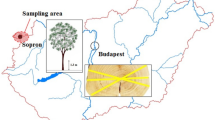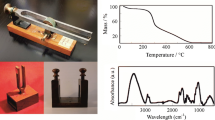Abstract
Waterlogged archaeological woods Pinus pinaster and Fagus sylvatica L. were analyzed by using TG technique. Degradation processes ascribable to the holocellulose decay were evidenced at nearly the same temperature for sound and archaeological samples. The residual matters at 600 and 900 °C of the sound woods are much lower than those of archaeological waterlogged woods in agreement with the presence of inorganic materials encapsulated during the burial into the marine environment. It was proposed a new protocol to rapidly calculate the maximum water content parameter, which is related to the wood degradation state. TG experiments at variable heating rates were performed to obtain kinetic parameters for the degradation process. The Flynn–Wall–Ozawa and Friedman approaches allowed us to calculate the activation energy, which is significantly different for the sound and the archaeological woods.








Similar content being viewed by others
References
Jordan BA. Site characteristics impacting the survival of historic waterlogged wood: a review. Int Biodeterior Biodegrad. 2001;47:47–54.
Giachi G, Capretti C, Macchioni N, Pizzo B, Donato ID. A methodological approach in the evaluation of efficacy of treatment for the dimensional stabilization of waterlogged archaeological wood. J Cult Herit. 2010;11:91–101.
Van Bergen PF, Imogen P, Ogilvie TMA, Caple C, Evershed RP. Evidence for demethylation of syringyl moieties in archaeological wood using pyrolysis-gas chromatography/mass spectrometry. Rapid Commun Mass Spectrom. 2000;14:71–9.
Popescu CM, Dobele G, Rossinskaja G, Dizhbite T, Vasile C. Degradation of lime wood painting supports evaluation of changes in the structure of aged lime wood by different physico-chemical methods. J Anal Appl Pyrolysis. 2007;79:71–7.
Bardet M, Foray MF. Trân QK high-resolution solid-state CPMAS NMR study of archaeological woods. Anal Chem. 2002;74:4386–90.
Salanti A, Zoia L, Tolppa EL, Giachi G, Orlandi M. Characterization of waterlogged wood by NMR and GPC techniques. Microchem J. 2010;95:345–52.
Colombini MP, Lucejkoa JJ, Modugno F, Orlandi M, Tolppa EL, Zoia L. A multi-analytical study of degradation of lignin in archaeological waterlogged wood. Talanta. 2009;80:61–70.
Franceschi E, Cascone I, Nole D. Thermal XRD and spectrophotometric study on artificially degraded woods. J Therm Anal Calorim. 2008;91:119–25.
Donato DI, Lazzara G, Milioto S. Thermogravimetric analysis: a tool to evaluate the ability mixtures in consolidating waterlogged archaeological woods. J Therm Anal Calorim. 2010;101:1085–91.
Campanella L, Tomassetti M, Tomellini R. Thermoanalysis of ancient, fresh and waterlogged woods. J Therm Anal Calorim. 1991;37:1923–32.
Streibel T, Geißler R, Saraji-Bozorgzad M, Sklorz M, Kaisersberger E, Denner T, Zimmermann R. Evolved gas analysis (EGA) in TG and DSC with single photon ionisation mass spectrometry (SPI-MS): molecular organic signatures from pyrolysis of soft and hard wood, coal, crude oil and ABS polymer. J Therm Anal Calorim. 2009;96:795–804.
Florian E (1989) Scope and history of archaeological wood Archaeological Wood, Ed American Chemical Society, Washington, DC 1990, p 8
Hedges JI. The chemistry of archaeological wood. In: Rowell RM, Barbour RJ, editors. Archaeological wood properties chemistry and preservation. Advances in Chemistry Series 225. Washington: American Chemical Society; 1990. p. 137
Wilkin RT, Barnes HL. Formation processes of framboidal pyrite. Geochim Cosmochim Acta. 1997;61:323–39.
Fors Y, Nilsson T, Risberg ED, Sandstrom M. Torssander P Sulfur accumulation in pinewood (Pinus sylvestris) induced by bacteria in a simulated seabed environment: implications for marine archaeological wood and fossil fuels. Int Biodeter Biodegradation. 2008;62:336–47.
Kim UJ, Eom SH, Wada M. Thermal decomposition of native cellulose: influence on crystallite size. Polym Degrad Stab. 2010;95:778–81.
Li J, Lib B, Zhang X. Comparative studies of thermal degradation between larch lignin and manchurian ash lignin. Polym Degrad Stab. 2002;78:279–85.
Merela M, Oven P, Sersa I, Mikac U. A single point NMR method for instantaneous determination of the moisture content of wood. Holzforschung. 2009;63:348–51.
Wang SX, Tan ZC, Li YS, Sun LX, Li Y. A kinetic analysis of thermal decomposition of polyaniline/ZrO2 composite. J Therm Anal Calorim. 2008;92:483–7.
Yu-Hsiang H, Chuh-Yung C, Cheng-Chien W. Viscoelastic properties and thermal degradation kinetics of silica/PMMA nanocomposites. Polym Degrad Stab. 2004;84:545–53.
Pielichowski K, Flejtuch K. Non-oxidative thermal degradation of poly(ethylene oxide): kinetic and thermoanalytical study. J Anal Appl Pyrolysis. 2005;73:131–8.
Budrugeac P, Segal E, Pérez-Maqueda LA, Criado JM. The use of the IKP method for evaluating the kinetic parameters and the conversion function of the thermal dehydrochlorination of PVC from non-isothermal data. Polym Degrad Stab. 2004;84:311–20.
Yao F, Wu Q, Lei Y, Guo W, Xu Y. Thermal decomposition kinetics of natural fibers: activation energy with dynamic thermogravimetric analysis. Polym Degrad Stab. 2008;93:90–8.
Criado JM, Sanchez-Jimenez PE, Perez-Maqueda LA. Critical study of the isoconversional methods of kinetic analysis. J Therm Anal Calorim. 2008;92:199–203.
Jiang G, Nowakowski DJ, Bridgwater AV. A systematic study of the kinetics of lignin pyrolysis. Thermochim Acta. 2010;498:61–6.
Donato ID, Armata N. Physical properties of waterlogged wood measurements with Accupyc 1330, Helium picnometer. In: Straetkvern K, Huisman DJ, editors. Proceedings of the 10th ICOM Group on wet organic archaeologic materials conference, Amsterdam. Amersfoort: Nederlandse Archeologische Rapporten, Drukkerij Stampij 2007;37:79–88.
Acknowledgements
The work was financially supported by the University of Palermo. We thank the “Fondazione Banco di Sicilia” which cofinanced the TGA Q5000 IR apparatus (Convenzione PR 4.b/08).
Author information
Authors and Affiliations
Corresponding author
Rights and permissions
About this article
Cite this article
Cavallaro, G., Donato, D.I., Lazzara, G. et al. A comparative thermogravimetric study of waterlogged archaeological and sound woods. J Therm Anal Calorim 104, 451–457 (2011). https://doi.org/10.1007/s10973-010-1229-3
Published:
Issue Date:
DOI: https://doi.org/10.1007/s10973-010-1229-3




